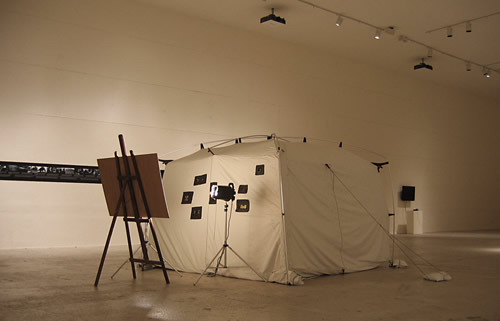Portable Camera Obscura: a quest
Trudi Lynn Smith

The installation Portable Camera Obscura is a walk-in, room-sized camera. A temporary architecture, it is a lightproof tent environment that projects an image of the outside view onto the walls of the tent with a simple lens. The image that projects into the tent is unfixed and only experienced by those who bear witness at that moment.
First positioned in the location of popular photographic views in Waterton Lakes National Park, Alberta, in summer 2009, participants were able to enter the tent to see the landscape projected onto the wall of the structure. Tracking historical photographs, the camera was installed in several popular locations for image-making in the park. I also mounted an expedition style journey into the back-country of Waterton. I invited community members that ‘speak for nature’ (wardens, ecologists, environmentalists, environmental educators) to attempt to re-locate an historical photograph. With me as the guide, we went on a quest to investigate historical photographs, to experiment with the distance between representation and represented, and to play with what a more ethically and ecologically sound relationship between image and place might look like. We took the archive out for a walk as a way to transform the historical photograph from a document (or monument) back into a located, community act. The tent was an experiential foundation for communication. A collaborative space, and an architecture of attention, the installation was built for loitering, conversations, and looking differently at a view and at a photographic act. This work focuses on active and dynamic experiences as catalysts for generating communicative processes that can spark new knowledge about nature and representation in Canada.

In the gallery space, Portable Camera Obscura forms a part of a larger project of gallery works that I install as social work-spaces to investigate archival photographs. One step removed from the site of production, and one more level of mediation, inside the Portable Camera Obscura the viewer sees a 50 x 72 cm hand tinted mid twentieth century photograph illuminated, “Waterton Lake from the Prince of Wales Hotel in Canada” taken in mid 20th century by the photographer Kabel, an employee of Great Northern Rail.
Biography
Trudi Lynn Smith is an interdisciplinary PhD student in the Departments of Anthropology and Visual Art at University of Victoria, Canada. Bringing together anthropology, art, and curatorial practice, she has conducted image-based research in Jasper, Banff and Waterton Lakes National Parks since 2002, investigating the relationship between photography and national park landscapes. She is particularly interested in the entanglement of art and science and explores the productive friction between the two in her research. She specializes in theoretical and methodological approaches to visual research and published in the journal Visual Anthropology (2007). In 2007, Trudi participated in the Artist Residency “Walking and Art”at the Banff Centre for the Arts. Recent and upcoming exhibitions include Fieldnotes at the Nanaimo Art Gallery (2008), various on-site works in Waterton Lakes National Park (2008-2010) including Portable Camera Obscura (2009-2010), and she has an upcoming exhibition at the Southern Alberta Art Gallery (Lethbridge, AB) in summer 2010.
Links:
